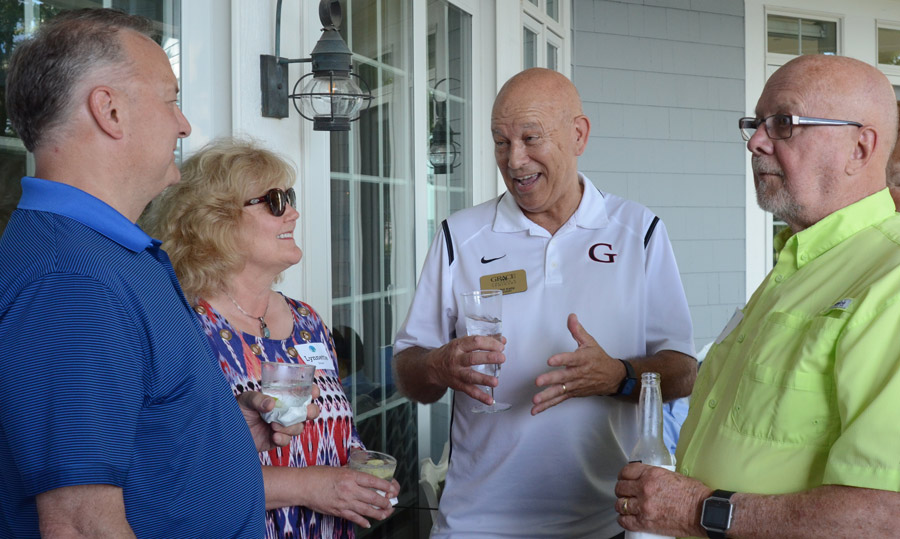SYRACUSE — “Imagine this 3,000 acres of water being corn and soybeans,” stated Randy Tobias to over 100 guests Saturday evening. “If it were, none of us would be here … this is what brings us here — water. What keeps us here is clean water.”
Randy and Deborah Tobias, along with several co-hosts, hosted a social event for friends on behalf of the Lilly Center for Lakes & Streams Saturday evening, June 29. The evening was to hear updates on studies by the center of Wawasee and Syracuse lakes, projects and the future endeavors.
Clik here to view.

Dr. Nate Bosch, center, director of the Lilly Center for Lakes & Streams, talks with hosts Deborah Tobias, left, and her husband, Randy Tobias, right.
Dr. Nate Bosch, director of the center, spoke of applied research, engaging education and collaborative efforts. “The Lilly Center is about clean water,” he stated, relating its work to an old pitcher pump with its donors, volunteers and those offering advice being those whose hands are on the pump to help prime it.
The purpose of the evening was to share goals for the future at the center. This was highlighted in three areas all starting with the letter “S” — scopes, sensors and students.
The scopes referred to are the microscopes needed as an investment for the center’s kindergarten through 12th grade educational programs. “If you think about it, a microscope is literally holding the health of your lake in the hands of a researcher or a student,” Bosch stated, noting with the bid demand for students wanting to come to the center, new curriculum and over 1,000 students expected in field trips next year, microscopes will be essential in education. It would also aid in research by students.
Two additional stream sensors were the second area noted. Three sensors are currently installed around Wawasee and Syracuse, collecting data every 10 minutes. The Doppler sensors are connected to a data collection system and through a cellphone signal sent to the center’s website. Real data is then available to the public. He added the sensors help researchers know what is coming into the lake, understand ag runoff, predict flooding and understand the water level, which is important for the future.
Clik here to view.

Dick Tillman checks out what may be living in the waters of Lake Wawasee. Researcher Jed Harvey is shown in the background.
The final area was students. “We want to attract even more (students) and develop the talents even better with the students we already have.” He noted this investment would be through scholarships and fellowships. “Students are investing in your lakes here and also in their future, learning to be environmental professionals.” Bosch added students from the center are scattered throughout the state in various environmental professions.
The presentation also briefly touched on the current status of the lake. Bosch noted the cool, wet spring has kept the water temperatures cooler. The current water temperature, at 71 degrees on the surface, is three weeks behind last year. The impact has been water clarity. “The visibility is better than the typical at this time,” Bosch stated. Current visibility is at 6 feet on Wawasee and 8 feet on Syracuse. “With the cooler water, the algae is not waking up as fast as it normally does,” he noted, adding there also has not been much boating activity.
Bosch stated with the amount of rain received, there has also been a lot of nutrients washing into the lake, which should prompt algae growth. “The weird thing is the cool water is impeding algae growth … it will be interesting as we track this over the summer months to see which wins out: the extra nutrients or cooler water temperatures.”
Additionally Bosch noted this was the first summer the center is doing samplings of toxins in-house. Samplings taken the first of the week are analyzed on Thursday with results known that afternoon. Bosch stated they are working on a notification system to get the word out should dangerous toxin levels ever be found.
During Bosch’s favorite time — that of questions and answers — it was learned 10 more microscopes and accessories were desired, where the three sensors are currently located and where two more would be placed. He also answered questions regarding the flow information, how people could “grab hold of the pump handle,” how data from the stream sensors is used, the boat study, the health of Wawasee and Syracuse, sewer studies and the use of organic fertilizer.
Bosch was introduced by Dr. Bill Katip, president of Grace College, who gave Bosch’s credentials but also noted Bosch’s accomplishments. “Nate is a great connector to the Lilly Center and to Grace College and other universities,” Katip stated.
Image may be NSFW.Clik here to view.
 Image may be NSFW.
Image may be NSFW.Clik here to view.
 Image may be NSFW.
Image may be NSFW.Clik here to view.
 Image may be NSFW.
Image may be NSFW.Clik here to view.
 Image may be NSFW.
Image may be NSFW.Clik here to view.
 Image may be NSFW.
Image may be NSFW.Clik here to view.
